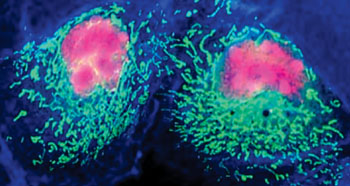Biomarker Found for Epithelial Cancer Stem Cells
By LabMedica International staff writers
Posted on 20 Oct 2014
Tumors are mosaics of cells that are morphologically and molecularly very different and over the past years have been suggested to be responsible for the origin of cancer and for the resistance to conventional chemical therapies.Posted on 20 Oct 2014
Cancer stem cells (CSCs) are thought to drive tumor growth, metastasis and chemoresistance but as there are only a small percentage of cancer stem cells in a solid tumor, this makes it difficult to isolate and analyze them, as well as to study the origin of drug resistance.

Image: Near-ultra violet induced autofluorescence shows significant differences between tumoral and healthy tissue (Photo courtesy of Dr. Geneviève Bourg-Heckly).
Scientists at the Spanish National Cancer Research Center (Madrid, Spain) identified cells with an autofluorescent subcellular compartment that exclusively showed CSC features across different human tumor types. Primary tumor–derived autofluorescent cells did not overlap with side-population (SP) cells, were enriched in sphere culture and during chemotherapy, strongly expressed pluripotency-associated genes, were highly metastatic and showed long-term in vivo tumorigenicity, even at the single-cell level.
Autofluorescence was due to riboflavin accumulation in membrane-bounded cytoplasmic structures bearing adenosine triphosphate (ATP)-dependent ATP-binding cassette sub-family G member 2 (ABCG2) transporters. The team was able to characterize an intrinsic autofluorescent phenotype in CSCs of diverse epithelial cancers and used this marker to isolate and characterize these cells. Riboflavin is a pigment that emits green fluorescence as a result of its accumulation inside intracellular vesicles. This light emission property, acts to track, isolate, and later purify it, without the need for antibodies or other more costly and complex techniques. The discovery was carried out in several types of tumors, including samples from patients with pancreas, liver, colon and lung cancer.
Christopher Heeschen MD, PhD, the senior author of the study said, “The discovery of this new marker is a breakthrough, as it can select for tumor stem cells, which are the most invasive and chemical-resistant cancer cells. Autofluorescence allows these cells to be tracked in an easy, simple and inexpensive way, as well as to study the origin of the tumor’s chemical resistance.” The study was published on September 28, 2014, in the journal Nature Medicine.
Related Links:
Spanish National Cancer Research Center













